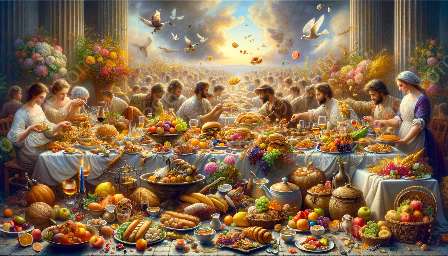Food is not only a necessity for sustenance but has also been a prominent subject in art, literature, culture, and history. This topic cluster delves into the portrayal of food in art, its depiction and significance in literature, and its role in shaping food culture and history.
Food References in Art
Art has often depicted food as a symbol of abundance, indulgence, and even scarcity. From still life paintings to food-centric sculptures, artists have explored the visual and sensory appeal of food. It serves as more than just a subject matter – it communicates cultural, social, and political messages.
Still Life Paintings
One of the most well-known artistic representations of food is through still life paintings. Dating back to ancient times, still life artworks often feature an arrangement of fruits, vegetables, and other edible items. Artists meticulously capture the texture, color, and form of food, inviting viewers to appreciate the beauty and transience of life.
Food as Symbolism
Food in art is often used as a symbol to convey deeper meanings. For example, the motif of a lavish feast might represent prosperity and wealth, while a depiction of sparse or rotten food could signify hardship and decay. Famous artists like Caravaggio and Francisco de Zurbarán have used religious narratives to portray food as a symbol of spiritual sustenance.
Food in Literature and Art
Literature often intertwines with visual art through the depiction of food. Authors and artists alike have employed food as a literary device to evoke emotions, convey cultural values, and create sensory experiences through words and images. From lavish banquets in classic novels to the culinary delights described in modern literature, food plays a central role in storytelling.
Culinary Descriptions in Literature
Authors have used vivid descriptions of food to transport readers into the world of their stories. Whether it's the sumptuous feasts in 'The Great Gatsby' by F. Scott Fitzgerald or the delectable confections in 'Charlie and the Chocolate Factory' by Roald Dahl, food becomes a character in itself, stimulating the imagination and enhancing the narrative.
Collaboration of Art and Literature
Writers and artists have collaborated, inspired, and influenced each other's work, leading to the creation of illustrated manuscripts, book illustrations, and literary-themed artworks. The fusion of visual and literary arts enhances the audience's experience, offering a multi-sensory journey where food becomes a bridge between text and image.
Food Culture and History
Food is deeply entwined with culture and history, reflecting societal norms, traditions, and changes over time. The study of food culture and history encompasses the evolution of culinary practices, the impact of globalization on food habits, and the role of food in shaping identity and community.
Culinary Traditions and Customs
Across different cultures, food is an integral part of traditions and customs. From the elaborate rituals of Japanese tea ceremonies to the communal gatherings around a traditional Italian meal, food serves as a means of bonding, celebration, and preservation of heritage.
Food as a Historical Marker
Food provides valuable insights into historical periods, migration patterns, and trade routes. The exchange of culinary traditions and ingredients has shaped global cuisines, marking significant historical events such as the Columbian Exchange and the Silk Road trade.
Food and Identity
Individual and collective identities are closely linked to food choices and preferences. Regional cuisines, dietary restrictions, and culinary practices reveal a community's cultural heritage and values, fostering a sense of belonging and interconnectedness.
Conclusion
Food references in art, literature, culture, and history offer a rich tapestry of human experiences and expressions. They capture the essence of nourishment, pleasure, symbolism, and identity, shaping our understanding of the role of food in shaping society and creativity.

